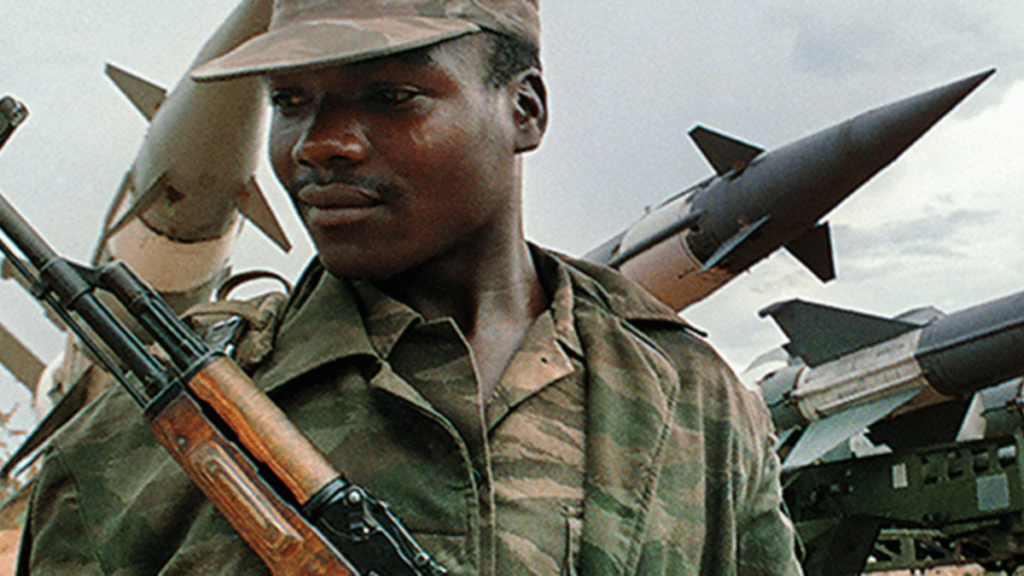The Cold War was so-called for a reason: the ‘war’ remained ‘cold’ between its two primary belligerents, the USSR and the USA.
Despite all the maneuvering between the two global superpowers, they never actually directed crossed swords for fear of the mutually assured destruction that would surely follow.
How, then, did these two international powerhouse nations ‘fight’ the Cold War? Simple – through the use of Cold War proxy wars.
But what, exactly, is a proxy war? Simply put, it’s a war in which two belligerents fight via proxies – third parties – by supporting them with materiel, intelligence, and occasionally boots-on-the-ground soldiers.
Proxy wars are fought in such a way that one or both supporting powers have plausible deniability and cannot be officially tied to the conflict (no matter how obvious their involvement is).
It goes without saying that there were a number of proxy wars and conflicts fought during the Cold War. Some are extremely famous and well-known to the general public (e.g., the Vietnam War), while others are not quite as well known.
It’s to the latter that we turn our attention to today; what other proxy wars went on during the Cold War? Who were the belligerents, and by whom were they backed?
Let’s take a look at the 4 biggest Cold War proxy conflicts you’ve never heard of.
The Chinese Civil War (1944-1949)
You’ve obviously heard of the Chinese Civil War – the war that gave us Maoist China and a functionally independent Taiwan. But what you likely didn’t know is that it was actually the first shot fired in the Cold War – before WWII had even finished.
Background
Chinese communists, backed by the USSR, had been agitating in China since the early 20s, and conflicts between the two were plentiful up until the Japanese invasion in 1937.
Even during that time, when the communists and the nationalists (AKA the Guomindang, commonly rendered as Kuomintang) worked together.
Following Japan’s capitulation, true civil war broke out between the two powers. The CCP (Chinese Communist Party) and their military arm, the PLA (People’s Liberation Army), fought against the Guomindang and their armed branch, the National Revolutionary Army. The former was backed by the USSR, while the latter was tacitly supported by the US.
Interestingly, the ties between the CCP and the former USSR haven’t changed, as we covered in a recent article that delved into how China May Still Be Considering Arming Russian Forces in Ukraine.
Victor: The CCP (USSR proxy)
The Korean War (1950-1953)
After China established itself as a world power following the Communist victory, they were embroiled in a number of proxy wars in order to protect ‘buffer’ states along their border.
The first such major proxy war was the Korean War of 1950-1953. Again, this is a war you’ve likely heard of – but you may not have been aware of its status as a proxy war.
Background
Following the Japanese surrender at the end of WWII, the Japanese-annexed country of Korea was divided into two administrative zones – the Soviet-administered north and the US-controlled south.
Both became sovereign nations in the following 20 years, with the newly-created North Korea led by the Soviet puppet ruler Kim Il-Sung, and South Korea establishing an autocratic capitalist state under Syngman Rhee.
Kim fired the first shots in 1950 after negotiations between the two states – both of which claimed sovereignty over the whole Korean Peninsula – failed.
After three years of bitter internecine warfare, the border between the two Koreas ended up more or less where it started, making the conflict a bloody yet pointless one. The two countries remain, today, officially at war.
Victor: none (stalemate)
Mau Mau Uprising (1952-1960)
This rebellion, which took place in the British-controlled African state of Kenya, took place between the Kenya Land and Freedom Army (colloquially known as the Mau Mau) and the occupying British colonial forces.
Background
The Mau Mau soldiers were tacitly supported by the Soviet Union, who had a vested interest in challenging Western imperialism wherever it reared its head; conversely, the British forces occupying Kenya were openly supported by their American allies.
The rebellion was marked by brutality and atrocities perpetrated by both sides. The Mau Mau rebels murdered civilians on more than one occasion, with their own allies condemning some of these attacks.
Conversely, the British were particularly vicious in their repression of the Mau Mau; prisoners suspected of being Mau Mau sympathizers were often tortured, with hot eggs or beer bottles being inserted into rectums or vaginas and many being summarily executed.
Though the Mau Mau were effectively defeated in 1956, the conflict was not formally ended until 1960, when Kenya transitioned to independence.
Victor: United Kingdom (US proxy)
Thailand Communist Insurgency (1965-1983)
One of the most long-lasting proxy wars of the Cold War is also one of the least well-known, with many people not even being aware of the fact that Thailand had a Communist insurgency lasting almost two decades.
Background
Communism had been illegal since the 1930s in Thailand, with the reigning government coming down brutally on anybody who identified as a communist.
However, with two major communist nations being established close to Thailand – the PRC and the Democratic Republic of Vietnam – communists and their sympathizers persisted in northern Thailand.
In the 1950s, Beijing received and trained several communist guerillas from northern Thailand.
The guerillas, who continued to recruit new members and send them for training both in China and North Vietnam, engaged in guerilla warfare and assassinated several Thai politicians. US Army bases in the country were also targeted.
The government brutally suppressed the uprising for many years, resulting in no small number of atrocities and a particularly notorious university massacre, where government forces killed dozens of students and injured more than a hundred in an attempt to suppress a leftist protest.
The insurgency effectively ended in 1983, when the government extended a laurel branch in the form of an amnesty that pardoned Communist Party of Thailand members and allowed them the opportunity to legitimately participate in the political process.
Victor: The Kingdom of Thailand
Cold War Proxy Wars Were Tragically Plentiful

We haven’t even begun to scratch the surface of Cold War proxy conflicts here – there were dozens if not hundreds, of such wars between the end of WWII in 1945 and the collapse of the Soviet Union in 1989.
Did we miss any of the more obscure of those proxy wars? Drop us a comment below to let us know your thoughts. And until next time, never start a land war in Asia!
Oh, and if you want to discover more undiscovered history surrounding the Cold War on WarAdvisor.com, we suggest you check out our popular articles, such as The Romanian AK 47: The Gun That Killed a Dictator or Why M. Kalashnikov Gave His Watch To a Rhodesian Soldier.


[…] across history’s battlegrounds, charting the important events of World War I, World War II, the Cold War, and more in unprecedented graphic detail. Key campaigns are portrayed and studied in detail, […]